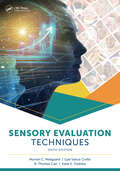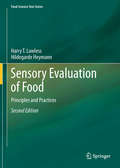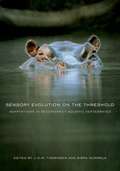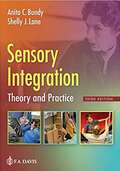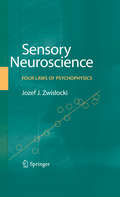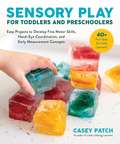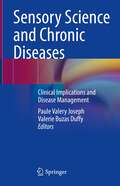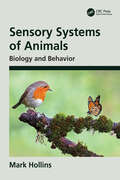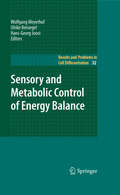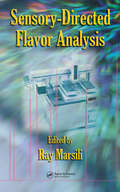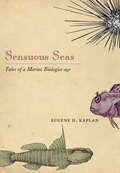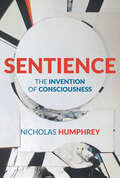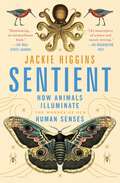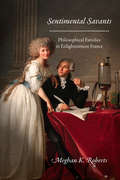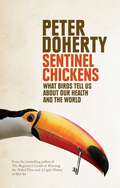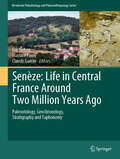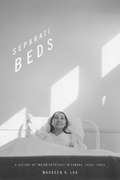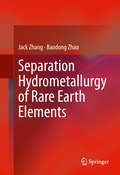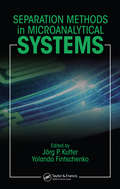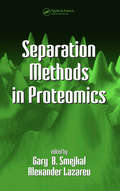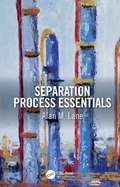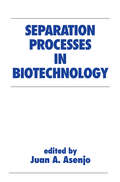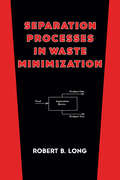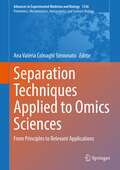- Table View
- List View
Sensory Evaluation Techniques
by Gail Vance Civille B. Thomas Carr Katie E. OsdobaThe sixth edition of this classic text brings sensory evaluation to life for new students and experienced professionals alike. A full array of sensory methods is covered – including descriptive techniques, discrimination testing, and consumer research, plus guidance on test design, statistical analysis, and how to translate results into insights for actionable decisions. Like its predecessors, Sensory Evaluation Techniques, Sixth Edition gives a clear and concise presentation of practical solutions, accepted methods, and standard practices, in addition to advanced techniques.What’s new in the sixth edition: An expanded chapter on Sensory Physiology, including recent research on individual differences in perception A thorough discussion of Thurstonian theory and its application to discrimination methods, including the Tetrad Test New sections on technology in sensory evaluation, including a discussion of software options for data collection Improved & updated case studies to aid learning comprehension Updated appendices for Spectrum Method attributes, references, and scales Updated references Online supplemental content Sensory Evaluation Techniques remains a practical, relevant, and flexible resource, providing how-to information for a wide variety of users in industry, government, and academia who need the most current information to conduct effective sensory research. It also supplies students with the necessary theoretical background in sensory evaluation methods, applications, and interpretations.
Sensory Evaluation of Food
by Hildegarde Heymann Harry T. LawlessThis volume covers all the basic techniques of sensory testing, from simple discrimination tests to home use placements for consumers. It provides fundamental theories, psychological and statistical, that form the basis and rationale for sensory test design. Statistics used in sensory evaluation are also demonstrated both as stand-alone material presented in appendices and as integrated applications in the context of appropriate sensory methods. Chapters are constructed so that beginning students who want only the practical aspects of conducting sensory test will see clear instruction on how test should be conducted. Advanced students and practitioners will enjoy the more detailed sections on rationale and related issues.
Sensory Evolution on the Threshold: Adaptations in Secondarily Aquatic Vertebrates
by J. G. M. Thewissen Sirpa NummelaThis synthesis explores the function and evolution of sensory systems in animals whose ancestors lived on land. Together, the contributors explore the dramatic transformation of smell, taste, sight, hearing, balance, mechanoreception, magnetoreception, and electroreception that occurred as lineages of amphibians, reptiles, birds, and mammals returned to aquatic environments.
Sensory Integration: Theory and Practice
by Shelly J Lane Anita C. Bundy“Perfect just what I needed for a course and it'sa great book[.] Would recommend to any Occupational therapist, speech, or physical therapist interested in working with the sensory population”—Alexandra A. <p><p> “This is a wonderful resource book for Occupational Therapists working with children. It is clear and easy reading for new and old therapists.”—Denise M. <p><p> “… written to enlarge existing understanding of sensory integration without intimidating the reader. The wealth of knowledge can help not only the new graduate, but also the more experienced practitioner.”—Mrs. Consuello M. <p><p> Drs. Bundy and Lane, with their team of contributing experts and scholars, provide guidance and detailed case examples of assessment and intervention based in sensory integration theory. They describe the neurophysiological underpinnings and synthesize current research supporting the theory and intervention.
Sensory Neuroscience: Four Laws of Psychophysics
by Jozef J. ZwislockiSensory Neuroscience: Four Laws of Psychophysics organizes part of psychophysics -- a science of quantitative relationships between human sensations and the stimuli that evoke them. Although psychophysics belongs to sensory neuroscience, and is coupled to neurophysiology, it has also branched out to various specialized disciplines, including the disciplines of vision and hearing, ophthalmology, optometry, otology, and audiology. Due to this diversification and fragmentation, psychophysics has had an ad-hoc, phenomenological orientation. Besides Weber's law of differential sensitivity, and the still-controversial Stevens' power law, it has lacked a systematic grid of scientific laws. Sensory Neuroscience: Four Laws of Psychophysics provides valid unifying principles and systematic applications for this otherwise fragmented precursor of experimental psychology, and defines four multisensory relationships of substantial generality between sensations and the underlying stimulus variables. This book will be particularly useful to auditory researchers, experimental psychologists, and behavioral neuroscientists.
Sensory Play for Toddlers and Preschoolers: Easy Projects to Develop Fine Motor Skills, Hand-Eye Coordination, and Early Measurement Concepts
by Casey PatchExplore taste-safe small worlds, create colorful pieces of art, and engage all five senses while investigating the great outdoors. Sensory play is a wonderful way to explore the world with your little learners!Sensory Play for Toddlers and Preschoolers is a practical, hands-on guide for parents and educators who want to inject more play into their children's day! Since this collection features simple sensory play ideas with items you already have in your home, playtime has never been easier. Inside the book, you&’ll find forty easy sensory play tubs and activities with extra bonus ideas for extending the activities even further! Not only will your child be learning and exploring through play, but you&’ll also be creating some magical memories of playtime that will last a lifetime! Learn how to get started with sensory play using tips, tricks, and sensory play staples.Follow quick and easy, tried and tested sensory base recipes designed to ignite the senses and inspire hours of sometimes messy, always memorable playtime.Create thoughtful sensory invitations and artworks while developing fine motor skills, hand-eye coordination, early measurement concepts and so much more! Sensory play allows our little learners to make connections as they explore the world around them using their senses of sight, smell, taste, sound, and touch. It&’s the beginning of a lifelong journey of scientific understanding and a wonderful way to connect and bond with your little learners! Projects include: Rainbow RiceCloud DoughSand FoamEdible MudWater TubRainbow SpaghettiFrozen Building BlocksOutdoor KitchenJell-O Bug RescueBubble Wrap Paintingsand more!
Sensory Science and Chronic Diseases: Clinical Implications and Disease Management
by Paule Valery Joseph Valerie Buzas DuffyThe textbook provides an overview of the sensory science field in the context of diseases such as obesity and Coronavirus disease 2019 (COVID-19). This book brings a summary of the state of the science in key areas and provides examples of translational science from using cellular and rodent models to human clinical trials and community health. The volume structure leads the reader through the physiology of taste and smell into how sensory testing for taste and smell is studied, basic mechanisms, various protocols that are used throughout the field along with the pros/cons of the current methods used. This resource is intended for classroom teaching, for novice researchers in sensory research as well as students and postdoctoral fellows. Example of courses are nutrition, basic nursing, interdisciplinary health courses, sensory perception (psychology), neuroscience, and medical courses, dentistry, food science and others.
Sensory Systems of Animals: Biology and Behavior
by Mark HollinsPerception in animals is a fascinating and challenging subject that calls to students from many disciplines. The aim of this book is to provide a knowledge base and unifying perspective on the field that will enable beginning researchers to chart their own course within it. The author describes, in a systematic but engaging way, the sensory systems of humans and other vertebrates, as well as arthropods and molluscs.Why is it important to understand the senses of animals? One reason is that human activities are changing the perceptual world of animals in ways that expose them to danger. From bright outdoor lighting disorienting migrating birds to human sonar driving whales to beach themselves; it is becoming increasingly important to find ways to reduce such dangers. This will require big changes in human behavior, and greater understanding of how animals react, physiologically and behaviorally, to anthropogenic changes in their environment.The emphasis throughout is on research, in both the behavioral/ethological and neuroscientific traditions, that has led to important discoveries. The functional anatomy of each system, from receptor cells to brain areas, is succinctly described, explaining how it underlies the animal’s sensory abilities and behavior. Overall descriptions of a sense for a class of animals (for example, hearing in arachnids) are interspersed with expanded coverage of that sense in a particular animal, such as the ogre-faced web-casting spider that does a backflip to capture an insect buzzing overhead. Evolutionary themes are found throughout the book, for example in describing the development of the vertebrate ear, and in the convergent evolution of the eyes of vertebrates and cephalopods.With over 500 references and 80 illustrations, this textbook is intended as primary reading for advanced undergraduates and beginning graduate students of biology, neuroscience, sensory psychology, and veterinary science. It will also be of interest to professionals and academics in these fields, and to anyone else who works with or studies animals.
Sensory and Metabolic Control of Energy Balance
by Hans-Georg Joost Wolfgang Meyerhof Ulrike BeisiegelThe prevalence of obesity has dramatically increased in western and westernized societies, making the disease the second leading cause of unnecessary deaths in the US. Obesity results from imbalanced metabolic regulation leading to excessive lipid storage. As important novel entities in metabolic regulation, taste receptors and their cells are critical elements that adapt the gustatory system to metabolic signals and vice versa. The role of taste receptor genes in gastrointestinal tissues, as well as their dynamic regulation in gustatory and non-gustatory tissues in response to metabolic cues, has become the focus of an entirely new and rapidly developing research field with impacts on fuel sensing, metabolic control, and ingestive behavior. This book reflects the recent scientific progress in the field of fuel sensing in the mouth, GI tract, and brain and examines the olfactory bulb as a potential metabolic sensor and the brain-gut endocrine axis. It also touches on relevant novel molecular and cellular mechanisms regulating lipid storage and metabolism and covers the identification and functional characterization of obesity genes. Lastly, it illustrates the use of insect models to study relevant problems of energy homeostasis.
Sensory-Directed Flavor Analysis
by Ray MarsiliToday, flavor chemists can generate copious amounts of data in a short time with relatively little effort using automated solid phase micro-extraction, Gerstel-Twister and other extraction techniques in combination with gas chromatographic (GC) analysis. However, more data does not necessarily mean better understanding. In fact, the ability to extr
Sensuous Seas: Tales of a Marine Biologist
by Eugene H. KaplanLearning marine biology from a textbook is one thing. But take readers to the bottom of the sea in a submarine to discover living fossils or to coral reefs to observe a day in the life of an octopus, and the sea and its splendors come into focus, in brilliant colors and with immediacy. In Sensuous Seas, Eugene Kaplan offers readers an irresistibly irreverent voyage to the world of sea creatures, with a look at their habitats, their beauty and, yes, even their sex lives. A marine biologist who has built fish farms in Africa and established a marine laboratory in Jamaica, Kaplan takes us to oceans across the world to experience the lives of their inhabitants, from the horribly grotesque to the exquisitely beautiful. In chapters with titles such as "Fiddler on the Root" (reproductive rituals of fiddler crabs) and "Size Does Count" (why barnacles have the largest penis, comparatively, in the animal kingdom), Kaplan ventures inside coral reefs to study mating parrotfish; dives 740 feet in a submarine to find living fossils; explains what results from swallowing a piece of living octopus tentacle; and describes a shark attack on a friend. The book is a sensuous blend of sparkling prose and 150 beautiful illustrations that clarify the science. Each chapter opens with an exciting personal anecdote that leads into the scientific exploration of a distinct inhabitant of the sea world--allowing the reader to experience firsthand the incredible complexity of sea life. A one-of-a-kind memoir that unfolds in remarkable reaches of ocean few of us can ever visit for ourselves, Sensuous Seas brings the underwater world back to living room and classroom alike. Readers will be surprised at how much marine biology they have learned while being amused.
Sentience: The Invention of Consciousness
by Nicholas HumphreyThe story of a quest to uncover the evolutionary history of consciousness from one of the world's leading theoretical psychologists.We feel, therefore we are. Conscious sensations ground our sense of self. They are crucial to our idea of ourselves as psychic beings: present, existent, and mattering. But is it only humans who feel this way? Do other animals? Will future machines? Weaving together intellectual adventure and cutting-edge science, Nicholas Humphrey describes in Sentience his quest for answers: from his discovery of blindsight in monkeys and his pioneering work on social intelligence to breakthroughs in the philosophy of mind.The goal is to solve the hard problem: to explain the wondrous, eerie fact of &“phenomenal consciousness&”—the redness of a poppy, the sweetness of honey, the pain of a bee sting. What does this magical dimension of experience amount to? What is it for? And why has it evolved? Humphrey presents here his new solution. He proposes that phenomenal consciousness, far from being primitive, is a relatively late and sophisticated evolutionary development. The implications for the existence of sentience in nonhuman animals are startling and provocative.
Sentient: How Animals Illuminate the Wonder of Our Human Senses
by Jackie HigginsPerfect for fans of The Soul of an Octopus and The Genius of Birds, this &“revelatory book&” (Sy Montgomery, New York Times bestselling author) explores how we process the world around us through the lens of the incredible sensory capabilities of thirteen animals, revealing that we are not limited to merely five senses.There is a scientific revolution stirring in the field of human perception. Research has shown that the extraordinary sensory powers of our animal friends can help us better understand the same powers that lie dormant within us. From the harlequin mantis shrimp with its ability to see a vast range of colors, to the bloodhound and its hundreds of millions of scent receptors; from the orb-weaving spider whose eyes recognize not only space but time, to the cheetah whose ears are responsible for its perfect agility, these astonishing animals hold the key to better understanding how we make sense of the world around us. &“An appealingly written, enlightening, and sometimes eerie journey into the extraordinary possibilities for the human senses&” (Kirkus Reviews, starred), Sentient will change the way you look at humanity.
Sentimental Savants: Philosophical Families in Enlightenment France
by Meghan K. RobertsThough the public may retain a hoary image of the lone scientific or philosophical genius generating insights in isolation, scholars discarded it long ago. In reality, the families of scientists and philosophers in the Enlightenment played a substantial role, not only making space for inquiry within the home but also assisting in observing, translating, calculating, and illustrating. Sentimental Savants is the first book to explore the place of the family among the savants of the French Enlightenment, a group that openly embraced their families and domestic lives, even going so far as to test out their ideas--from education to inoculation--on their own children. Meghan K. Roberts delves into the lives and work of such major figures as Denis Diderot, Émilie Du Châtelet, the Marquis de Condorcet, Antoine Lavoisier, and Jérôme Lalande to paint a striking portrait of how sentiment and reason interacted in the eighteenth century to produce not only new kinds of knowledge but new kinds of families as well.
Sentinel Chickens: What Birds Tell Us About Our Health And Our World
by Peter Doherty'The idea of 'sentinel chickens' seemed pretty incongruous when I first heard the phrase as a young undergraduate ... The notion of the humble chicken waiting like a trained soldier, alert and focused, for some unseen and approaching enemy just didn't seem likely. Hens en garde!' And yet guard they do. Not only chickens, but puffins, eagles, canaries and toucans- birds of all kinds are recruited by humans to help us interpret changes in our increasingly challenged and unpredictable world. These wonderful creatures continually sample the atmosphere, oceans, fields and forests, signalling toxic and environmental dangers that threaten all vertebrates. Through personal stories and fascinating examples, Nobel prizewinner Peter Doherty shows also how birds have contributed to cutting-edge medical research. Studying birds has helped us to understand the nature of human cancer, malaria and influenza, and contributed to the development of new vaccines and cures. In his trademark style, Peter argues that since birds pollenate, spread plant seeds and control insects, endangering their habitats through human activities is a threat to our own wellbeing. Sentinel Chickens shows why we should give our feathered friends our close, sustained and caring attention.
Senèze: Paleontology, Geochronology, Stratigraphy and Taphonomy (Vertebrate Paleobiology and Paleoanthropology)
by Eric Delson Martine Faure Claude GuérinThe paleontological site of Senèze (Haute Loire, central France) was discovered in 1892 inside a volcanic crater. For over 40 years, local peasant Pierre Philis collected fossils and sold them to French and Swiss museums. The site became world-famous for its well-preserved skeletons of ungulates and carnivores, as well as rare but well-preserved remains of primates and other mammals. It is considered the reference fauna for the late Villafranchian and MNQ 18 biochronological units of European mammalian evolution, but the lack of provenance data made modern research difficult. From 2000-2006, the multidisciplinary Franco-American Senèze Research Project undertook five seasons of major fieldwork, with the goals of clarifying the age, stratigraphy and taphonomy of Senèze, as well as finding additional remains, especially of the less well-known taxa. In this volume, following a history of study and summary of the new fieldwork, four geological chapters consider field methods, stratigraphy, volcanology and dating. Combining argon-argon ages and paleomagnetic calibration, the newly recovered fossils are shown to date between 2.20 and 2.08 Ma, with concentrations ca. 2.20-2.18 and 2.10-2.08 Ma, significantly older than previously thought. Chapters on palynology, ichthyology and ornithology are followed by eight chapters on the fossil mammals. The chapter on biochronology places Senèze among other sites at the start of MNQ 18, which is estimated to end ca. 1.7 Ma. Of some 2200 specimens known from the site, over half are cervids, with bovids, rhinocerotids and equids far behind. According to data from palynology and the habitat preferences of the more common mammals, the paleoenvironment around the Senèze maar would have included forest, woodland and grassland, perhaps in a warmer and moister climate than today. Taphonomic studies revealed that bones often rested a long time under water, lacked any indication of carnivore attack and often displayed pathologies in their joints. It is likely that most of the associated skeletons were preserved undisturbed after large mammals fell into the paleolake and drowned without being able to climb out. This book responds to the long-held desire of later Cenozoic paleontologists to see a modern study of a site recognized worldwide as a biochronologic reference for the Plio-Pleistocene. Our study required renewed fieldwork using up to date techniques of topography, sedimentology, stratigraphy, geochronology and taphonomy. The systematic paleontology chapters are based on re-study of the entire body of Senèze fossils collected during more than a century of research. The volume will be of interest to paleontologists, especially those concerned with the evolution of the European fauna and with the taxa studied, as well as with paleoenvironmental reconstruction and biogeography. It will also be of value to mammalogists interested in analyses of near-modern taxa and to paleoanthropologists, archaeologists and taphonomists interested in the methods utilized and the role of Senèze as a comparative standard for a site of this age without human intervention. It will surely be an essential reference for all those who want to know more about Life in Central France Around Two Million Years Ago.
Separate Beds: A History of Indian Hospitals in Canada, 1920s-1980s
by Maureen K. LuxSeparate Beds is the shocking story of Canada's system of segregated health care. Operated by the same bureaucracy that was expanding health care opportunities for most Canadians, the "Indian Hospitals" were underfunded, understaffed, overcrowded, and rife with coercion and medical experimentation. Established to keep the Aboriginal tuberculosis population isolated, they became a means of ensuring that other Canadians need not share access to modern hospitals with Aboriginal patients.Tracing the history of the system from its fragmentary origins to its gradual collapse, Maureen K. Lux describes the arbitrary and contradictory policies that governed the "Indian Hospitals," the experiences of patients and staff, and the vital grassroots activism that pressed the federal government to acknowledge its treaty obligations.A disturbing look at the dark side of the liberal welfare state, Separate Beds reveals a history of racism and negligence in health care for Canada's First Nations that should never be forgotten.
Separating Cells (The\basics Ser.)
by Dipak PatelSeparating Cells: The basics provides user-friendly and practical guidance to the techniques most commonly used to separate cells. The book offers a concise overview of the fundamental principles and explains the 'what, how and why'. This title will be of considerable interest to newcomers to these techniques.
Separation Hydrometallurgy of Rare Earth Elements
by Jack Zhang Baodong Zhao Bryan SchreinerThis book describes in a comprehensive manner the technical aspects of separation of rare earth elements into individual elements for industrial and commercial use. The authors include details on and differentiate among the effective separation of rare earth elements for various parts of the world. They introduce new applications of separation of rare earth elements from concentrates of diverse ore types.
Separation Methods In Microanalytical Systems
by Jörg P. Kutter Yolanda FintschenkoFocusing on what has been one of the driving forces behind the development of lab-on-a-chip devices, Separation Methods in Microanalytical Systems explores the implementation, realization, and operation of separation techniques and related complex workflows on microfabricated devices. The book details the design, manufacture, and integration of diverse components needed to perform an entire analytical procedure on a single miniaturized device. This volume is valuable reference for scientists and engineers anticipating the demand for function-specific chemical separation systems in biomedical diagnostics, environmental monitoring, and drug discovery applications.
Separation Methods In Proteomics
by Gary B. Smejkal Alexander LazarevDriven by the widespread growth of proteomic practices, protein separation techniques have been refined to minimize variability, optimize particular applications, and adapt to user preferences in the analysis of proteins.Separation Methods in Proteomics provides a comprehensive examination of all major separation techniques for proteomic
Separation Process Essentials
by Alan M. LaneSeparation Process Essentials provides an interactive approach for students to learn the main separation processes (distillation, absorption, stripping, and solvent extraction) using material and energy balances with equilibrium relationships, while referring readers to other more complete works when needed. Membrane separations are included as an example of non-equilibrium processes. This book reviews and builds on material learned in the first chemical engineering courses such as Material and Energy Balances and Thermodynamics as applied to separations. It relies heavily on example problems, including completely worked and explained problems followed by "Try This At Home" guided examples. Most examples have accompanying downloadable Excel spreadsheet simulations. The book also offers a complementary website, http://separationsbook.com, with supplementary material such as links to YouTube tutorials, practice problems, and the Excel simulations. This book is aimed at second and third year undergraduate students in Chemical engineering, as well as professionals in the field of Chemical engineering, and can be used for a one semester course in separation processes and unit operations.
Separation Processes in Biotechnology (Biotechnology And Bioprocessing Ser. #9)
by Juan A. AsenjoEdited to avoid duplication and favor comprehensiveness, 20 contributors detail the recovery, separation, and purification operations of bioprocess technology. Individual chapters in this classic yet still highly relevant work emphasize concepts that are becoming more and more important when applied to the large scale versions of techniques that are considered well established. Aside from fully discussing processes, Separation Processes in Biotechnology includes sections on concentration separation and operation, purification operations, and product release and recovery. It also discusses plant operation and equipment and delves into economic considerations
Separation Processes in Waste Minimization
by Robert B. LongThis work offers an accessible discussion of current and emerging separation processes used for waste minimization, showing how the processes work on a day-to-day basis and providing troubleshooting tips for equipment that doesn't function according to design specifications. It describes the fundamentals of over 30 processes, types of equipment available, vendors, and common problems encountered in operations with hazardous waste.
Separation Techniques Applied to Omics Sciences: From Principles to Relevant Applications (Advances in Experimental Medicine and Biology #1336)
by Ana Valéria Colnaghi SimionatoThis book covers liquid chromatography, gas chromatography and capillary electrophoresis, the three main separation techniques lately available, applied to key omic sciences, such as genomics, proteomics, metabolomics and foodomics. The fundamentals of each technique are not covered herein. Instead, the recent advances in such techniques are presented focusing on the application to omics analyses and unique aspects in each case. This volume intends to offer wide ranging options available to researchers on omics sciences, and how to integrate them in order to achieve the comprehension of a biological system as a whole. Omic sciences have been of ultimate importance to comprehend the complex biochemical reactions and related events that occurs upon a biological system. The classical central dogma of molecular biology, which states that genetic information flows unidirectionally from DNA to RNA and then to proteins, has been gradually replaced by the systems biology approach. This book presents a multidisciplinary approach that explains the biological system as a whole, where the entire organism is influenced by a variety of internal events as well as by the environment, showing that each level of the biological information flux may influence the previous or the subsequent one.
